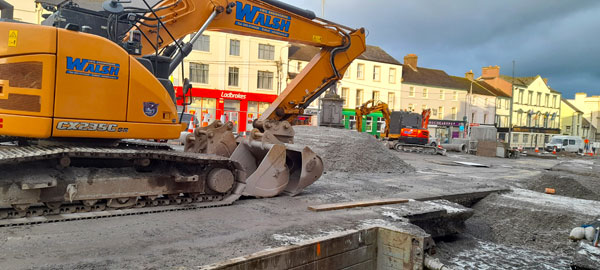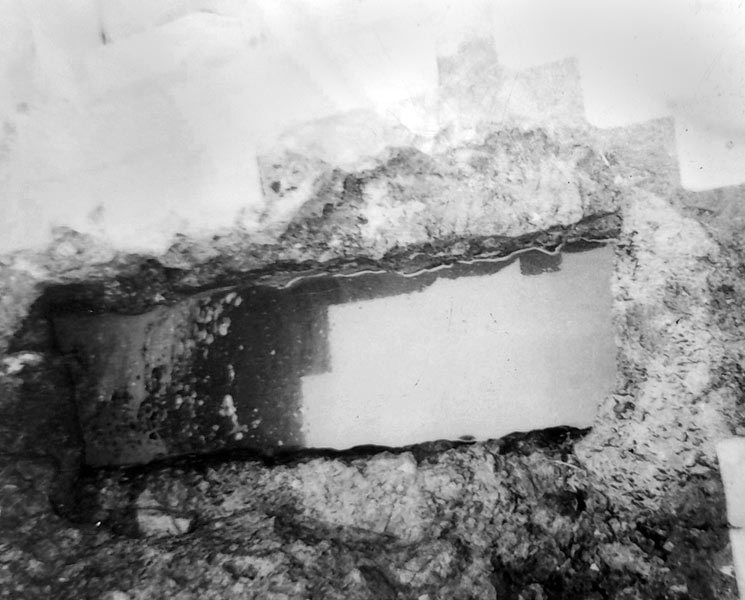Today’s work being carried out on Liberty Square was initially the brainchild of visionary Mr Tomas (Tom) Barry, latter former Thurles Town Manager.
Back in 2002, following discussions with his Council Administrative Staff including Mr Michael Ryan, (latter then holding the post of Town Clerk), Mr Barry decided to promote a proposal to Thurles District Councillors [Today’s paid elected Municipal District Councillors], to increase the town’s overall ‘Commercial Rates’ by 25%, in the upcoming 2003 Budget estimates, bringing it into line with other Irish towns of a similar size.
His forward looking plan was that some 15% of this 25% increase would be immediately ‘ring fenced,’ to meet local contributions required for a possible number of future Capital Projects within the town. It was anticipated back then that this 15% would yield some €200,000.00 per annum.
Barry’s 2002 Vision for the Future of Thurles.

Mr Tom Barry, in his five point visionary plan to drag Thurles town into the 21st century and into line with other Irish towns of similar size, unveiled the following projects as listed hereunder:-
(1). Thurles Town Centre Enhancement. (2). A Regional Arts Centre. ✓. (3). A Leisure Centre. ✓. (4). Thurles Town Park ✓ and a River Walk. (5). Upgrading / Extension to Thurles Council Offices, ✓, (Latter then grossly overcrowded and unfit for day to day business transactions.)
In relation to the Town centre Enhancement Scheme, he stated that such would dramatically augment an overall appearance of Thurles town centre.
Having shared his vision with Town Councillors, Mr Barry’s proposals were considered 19 years ago, at the 2003 Budget Meeting, latter which was held on Thursday, December 19th 2002. This aforementioned Budget meeting, which called for the introduction of this 25% Commercial Rates increase, was formally adopted by Thurles Council, by a 5 votes majority, with two other councillors unavoidably absent from that meeting.
One of those councillors who voted ‘Against’ Mr Tom Barry’s future vision for Thurles, was current day, Thurles Municipal Councillor, Mr Jim Ryan. Nevertheless, despite Councillor Jim Ryan’s objections, Thurles, within the next 16 years could rightly boast a new Regional Arts Centre, a new Library, a new Leisure Centre, an Extension to Thurles Council Offices and a new Thurles Town Park, courtesy of Thurles Commercial Rate payers.
All that is missing from Mr Barry’s vision today, is a properly maintained River Walk and the full completion of the enhancement to the Thurles Town Centre, latter now currently well advanced.
Alas, those were the days when rate payer’s money was carefully minded; local councils had employees; streets were kept clean and potholes were filled.
Note: All of these facts, above stated, are contained in Thurles Town Council Minutes, requested by me in the past, for my own perusal and available on request by the public for little charge.
Today, February 2nd, 2021; as part of the current upgrade to Liberty Square, it appears that sewer pipes are being installed.
It is therefore interesting to note that not one single politician or Municipal District councillor was present at a meeting in Thurles on Friday November 13th 1846, when the first ever sewage system was installed.
Present were the administrators of varying churches; Rev. Dr. Henry Cotton (Chairperson), Rev. Mr Laffan, Rev. Dr. O’Connor, Rev. Mr Barron. Rev. P Leahy, Rev. Mr Baker, Mr Francis O’Brien Esq. (Latter Justice of the Peace) and our old friend now well introduced to present day unproductive Municipal District councillors and useless politicians, yes, Dr. Robert Charles Knaggs, who had urgently instigated the building of a “Double Ditch”, thus placing food into the mouths of those close to starvation and death.
At this meeting in 1846, which began promptly at 3:00pm in today’s Ulster Bank building on Liberty Square, (then the home of the said Dr. Robert Charles Knaggs), details of the number of paupers then in the Poor House (former site of today’s Hospital of the Assumption) were recorded by the acting secretary, yes the same Dr. Robert Charles Knaggs.
“The original Poor House built in 1840, to accommodate 700 persons, had contained within it, “84 men, 184 women, 414 children — in all a total of 682 homeless, destitute persons.“
Being a medical doctor, Dr. Robert Knaggs was well aware of problems linked to a severe lack of hygiene. There were within the town of Thurles no sewers, people merely emptied their defecation into the nearest three cornered ‘shit well’, latter located, staggered in the various back lanes within the town. Contents of same wells would be removed weekly by an operating ‘Honey Waggon’ (Horse drawn covered wagon) to be spread on farm land as fertiliser and also, quickly recycled, by Crows, Jackdaws and other bird life.
“Having discussed and resolved that 20 barrels of wheat should be purchased in the local market the following day, to be ground into meal, for distribution to those starving. Meal tickets (the 2nd only provision of such in Thurles) were issued on that same day, numbered as follows:- Stradavoher 601 to 700, Garryvicleheen (Abbey Rd. Area) 701 to 800, Pudding Lane (O’Donovan Rossa Street) 801 to 900, Quarry Street (Mitchel Street) 901 to 1000, Pike Street (Kickham Street) 1001 to 1100 and Main Street (today’s Liberty Square & Cathedral Street combined) 1101 to 1120.”
However, before the meeting concluded and adjourned to 3:00pm on the following Monday, the acting secretary Dr. Robert Charles Knaggs suggested that a large number of unemployed men could be employed on making the first sewers through the town, if there was a quarry made available. Chairperson Rev. Dr. Henry Cotton offers the use of a quarry situated on his land.
In less than 3 weeks, by November 30th 1846, plans had been drawn up as follows: –
- To construct 42 perches (231yds/211.2m) of sewers from Rich’d Ryan’s to the Derheen, costed at £84.
- To construct 96 perches (528yds/482.8m) of sewers from Danl Dwyer’s to the bridge, costed at £192
- To construct 66 perches (363yds/331.9m) of sewers from Butler’s Gate to James Maher’s Yard, costed at £132.
- To construct 9 perches (49.9yds/44.8m) of sewers from the Barracks (Opposite todays Premier Hall) to the Main Street, costed at £185.
- To construct 66 perches(363yds/331.9 m) of covered drain or sewer from the bridge to the turn of the Mall with a tunnel under the river, and open a drain from the bridge in Thurles to Byrne’s Mill with a tunnel under the Drish River to carry up the levels for the drains of the town, costed at £800.
Total for this complete work, on wages of 8p per day, was estimated at costing £1,226.

Pictured in 1995, note the neat hand cut stone positioned on either side of the drain, lead lined and hidden by the water a flat 2.5in slate bottom. These sewers were so well built that many years later, they were used to accommodate modern day sewage pipes, by Thurles town council.
Additional works had also been approved of earlier for the Thurles area, on Thursday November 26th 1846, by the then Board of Works, consisting of the following, using available labour: –
- Construct 400 perches (2,200yds / 2011.6m) of the road from Thurles to Urlingford between Lisduff and the Fort on the Widow Keogh’s farm at Rahealty, costed at £150.00.
- To lower and remake two footpaths one from the corner of Pierce McLoughlin’s Delph shop (Today’s AIB Bank building, Liberty Square) to the Thurles Court House pier, being 22½ perches (123.75yds/113.16m) and the other from John Finn’s Hardware shop corner (Todays Carphone Warehouse, Liberty Square), back to the Police Barracks on the other side, (Opposite todays Premier Hall), being 19 perches (104.5yds/104.7m) costed at £10-7-6.
- To repair 600 perches (3,300yds/3,017.5m) of the road from Athlumon Ford to Godfrey’s Mills costed at £80.00.
- To repair 200 perches (1,100yds/1005.8m) of the road from Patrick Lahey’s gate at Kilrush to the Widow Shea’s house, Burris Road.
“Following a meeting held on December 4th 1846 the committee confirmed that 740 persons were in the Thurles Work House, as already stated, latter built only to accommodate 700 souls.”
By Tuesday, February 9th 1847 (Black 47), 1,991 persons were now employed, receiving wages from mostly local funding, at the above works listed hereunder: –
At Ballygammane – 84 employed persons, Pierstown Road – 56 persons, Seskin – 59 persons, cutting stone at the Stone Depot – 535 persons, at Drish Hill – 40 persons, at Rossestown Hill – 100 persons, working on Thurles Sewers – 163 persons, doing ‘Pathing’ – 225 persons, working on Embankment – 116 persons, on Kilrush Road – 47 persons, on the Widow Shea’s Road – 41 persons, on Turtulla Towpath – 82 persons, on Garrenrow Road - 100 persons, in Rahealty and Lisduff - 35 persons.
The then Member of Parliament (MP) for Tipperary, Mr Nicholas V Maher Esq. (Repeal Association MP and a member of the all-male, liberal Reform Club founded in 1836), subscribed £50 to the project. The absent then owner / landlord of Thurles, Viscount de Chabot, (Louis William de Rohan) also subscribed £50 and his son Count de Jarnac (Philippe-Ferdinand-Auguste de Rohan-Chabot). subscribed £10.
Their subscriptions compared dismally with the generosity of the aforementioned committee member present at the meeting, Mr Francis O’Brien Esq. JP (Justice of the Peace), who subscribed £30, and Rev. Dr. Michael Slattery, Archbishop of Cashel & Emly who subscribed £50.
This is the Dr. Robert Charles Knaggs, whom Tipperary Co. Council officials, together with Thurles Municipal District Councillors and our ever “Welcoming”, “Paste & Copy pictures of myself standing beside achievers to Facebook “ local elected politicians, through their ignorance, over the past 12 months, have stupidly decided to erase from our rich Thurles history.
One wonders if the “Double Ditch” got a mention in the first draft of the Renewal Strategy report presented to Thurles Councillors and their silent senior officials, on Monday, January 18th, 2021.
Thurles People can now surely understand fully, the phrase, “Eaten bread is soon forgotten”.

Re-Thurles Looking Back – as usual – both interesting and informative – thanks